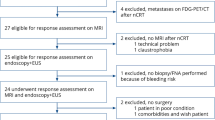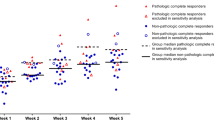Abstract
Purpose
In about 30% of patients treated with neoadjuvant chemoradiotherapy (nCRT) followed by surgical resection for locally advanced oesophageal cancer no vital tumour is found in the resection specimen. Accurate clinical response assessment is critical if deferral from surgery is considered in complete responders. Our study aimed to compare the performance of MRI and of FDG-PET/CT for the detection of residual disease after nCRT.
Methods
Patients with oesophageal cancer eligible for nCRT and oesophagectomy were prospectively included. All patients underwent FDG-PET/CT and MRI before and between 6 and 8 weeks after nCRT. Two radiologists scored the MRI scans, and two nuclear medicine physicians scored the FDG-PET/CT scans using a 5-point score for residual disease. Histopathology after oesophagectomy represented the reference standard. Sensitivity, specificity, and area under the receiver operating characteristic curve (AUC) were calculated for detection of residual tumour (ypT+), residual nodal disease (ypN+), and any residual disease (ypT+Nx/ypT0N+).
Results
Seven out of 33 (21%) patients had a pathological complete response. The AUCs for individual readers to detect ypT+ were 0.71/0.70 on diffusion-weighted (DW)-MRI and 0.54/0.57 on FDG-PET/CT, and to detect ypN+ were 0.89/0.81 on DW-MRI and 0.75/0.71 on FDG-PET/CT. The AUCs/sensitivities/specificities for the individual readers to detect any residual disease were 0.74/92%/57% and 0.70/96%/43% on MRI; these were 0.49/69%/29% and 0.60/69%/43% on FDG-PET/CT, respectively.
Conclusion
MRI reached higher diagnostic accuracies than FDG-PET/CT for the detection of residual tumour in oesophageal cancer patients at 6 to 8 weeks after nCRT.


Similar content being viewed by others
References
Bray F, Ferlay J, Soerjomataram I, Siegel RL, Torre LA, Jemal A. Global cancer statistics 2018: GLOBOCAN estimates of incidence and mortality worldwide for 36 cancers in 185 countries. CA Cancer J Clin. 2018;68:394–424. https://doi.org/10.3322/caac.21492.
Sjoquist KM, Burmeister BH, Smithers BM, Zalcberg JR, Simes RJ, Barbour A, et al. Survival after neoadjuvant chemotherapy or chemoradiotherapy for resectable oesophageal carcinoma: an updated meta-analysis. Lancet Oncol. 2011;12:681–92. https://doi.org/10.1016/s1470-2045(11)70142-5.
Biermann K, Van Lanschot JJB, Rozema T, Beukema JC, van Hagen P, Nieuwenhuijzen GAP, et al. Preoperative chemoradiotherapy for esophageal or junctional cancer. N Engl J Med. 2012;366:2074–84. https://doi.org/10.1056/NEJMoa1112088 Accessed Sept 20th, 2019.
Bedenne L, Mariette C Comparison of systematic surgery versus surveillance and rescue surgery in operable oesophageal cancer with a complete clinical response to radiochemotherapy (Esostrate). Available via https://clinicaltrials.gov/show/NCT02551458. Accessed Sept 20th, 2019
Noordman BJ, Wijnhoven BPL, Lagarde SM, Boonstra JJ, Coene P, Dekker JWT, et al. Neoadjuvant chemoradiotherapy plus surgery versus active surveillance for oesophageal cancer: a stepped-wedge cluster randomised trial. BMC Cancer. 2018;18:142. https://doi.org/10.1186/s12885-018-4034-1.
Kroese TE, Goense L, van Hillegersberg R, de Keizer B, Mook S, Ruurda JP, et al. Detection of distant interval metastases after neoadjuvant therapy for esophageal cancer with 18F-FDG PET(/CT): a systematic review and meta-analysis. Dis Esophagus. 2018;31. https://doi.org/10.1093/dote/doy055.
Stiekema J, Vermeulen D, Vegt E, Voncken FEM, Aleman BMP, Sanders J, et al. Detecting interval metastases and response assessment using 18F-FDG PET/CT after neoadjuvant chemoradiotherapy for esophageal cancer. Clin Nucl Med. 2014;39:862–7. https://doi.org/10.1097/rlu.0000000000000517.
de Gouw D, Klarenbeek BR, Driessen M, Bouwense SAW, van Workum F, Futterer JJ, et al. Detecting pathological complete response in esophageal cancer after neoadjuvant therapy based on imaging techniques: a diagnostic systematic review and meta-analysis. J Thorac Oncol. 2019;14:1156–71. https://doi.org/10.1016/j.jtho.2019.04.004.
Eyck BM, Onstenk BD, Noordman BJ, Nieboer D, Spaander MCW, Valkema R, et al. Accuracy of detecting residual disease after neoadjuvant chemoradiotherapy for esophageal Cancer. Ann Surg. 2020;271:245–56. https://doi.org/10.1097/sla.0000000000003397.
Koh DM, Collins DJ. Diffusion-weighted MRI in the body: applications and challenges in oncology. AJR Am J Roentgenol. 2007;188:1622–35. https://doi.org/10.2214/AJR.06.1403.
Le Bihan D, Poupon C, Amadon A, Lethimonnier F. Artifacts and pitfalls in diffusion MRI. J Magn Reson Imaging. 2006;24:478–88. https://doi.org/10.1002/jmri.20683.
Lambregts DM, Rao SX, Sassen S, Martens MH, Heijnen LA, Buijsen J, et al. MRI and diffusion-weighted MRI volumetry for identification of complete tumor responders after preoperative chemoradiotherapy in patients with rectal cancer: a bi-institutional validation study. Ann Surg. 2015;262:1034–9. https://doi.org/10.1097/SLA.0000000000000909.
Maas M, Lambregts DM, Nelemans PJ, Heijnen LA, Martens MH, Leijtens JW, et al. Assessment of clinical complete response after chemoradiation for rectal cancer with digital rectal examination, endoscopy, and MRI: selection for organ-saving treatment. Ann Surg Oncol. 2015;22:3873–80. https://doi.org/10.1245/s10434-015-4687-9.
Vollenbrock SE, Voncken FEM, van Dieren JM, Lambregts DMJ, Maas M, Meijer GJ, et al. Diagnostic performance of MRI for assessment of response to neoadjuvant chemoradiotherapy in oesophageal cancer. Br J Surg. 2019;106:596–605. https://doi.org/10.1002/bjs.11094.
Boellaard R, Delgado-Bolton R, Oyen WJ, Giammarile F, Tatsch K, Eschner W, et al. FDG PET/CT: EANM procedure guidelines for tumour imaging: version 2.0. Eur J Nucl Med Mol Imaging. 2015;42:328–54. https://doi.org/10.1007/s00259-014-2961-x.
Meijer GJ, Moerland MA, van Lier ALHMW, Lever FM, Lips IM, van Vulpen M, et al. Quantification of esophageal tumor motion on cine-magnetic resonance imaging. Int J Radiat Oncol Biol Phys. 2014;88:419–24. https://doi.org/10.1016/j.ijrobp.2013.10.036.
Lambregts DM, Vandecaveye V, Barbaro B, Bakers FC, Lambrecht M, Maas M, et al. Diffusion-weighted MRI for selection of complete responders after chemoradiation for locally advanced rectal cancer: a multicenter study. Ann Surg Oncol. 2011;18:2224–31. https://doi.org/10.1245/s10434-011-1607-5.
Noordman BJ, Spaander MCW, Valkema R, Wijnhoven BPL, van Berge Henegouwen MI, Shapiro J, et al. Detection of residual disease after neoadjuvant chemoradiotherapy for oesophageal cancer (preSANO): a prospective multicentre, diagnostic cohort study. Lancet Oncol. 2018;19:965–74. https://doi.org/10.1016/S1470-2045(18)30201-8.
Rice TW, Blackstone EH, Rusch VW. 7th edition of the AJCC Cancer Staging Manual: esophagus and esophagogastric junction. Ann Surg Oncol. 2010;17:1721–4. https://doi.org/10.1245/s10434-010-1024-1.
Mandard AM, Dalibard F, Mandard JC, Marnay J, Henry-Amar M, Petiot JF, et al. Pathologic assessment of tumor regression after preoperative chemoradiotherapy of esophageal carcinoma. Clinicopathol Correlations Cancer. 1994;73:2680–6.
DeLong ER, DeLong DM, Clarke-Pearson DL. Comparing the areas under two or more correlated receiver operating characteristic curves: a nonparametric approach. Biometrics. 1988;44:837–45. https://doi.org/10.2307/2531595.
Aoyagi T, Shuto K, Okazumi S, Shimada H, Kazama T, Matsubara H. Apparent diffusion coefficient values measured by diffusion-weighted imaging predict chemoradiotherapeutic effect for advanced esophageal cancer. Dig Surg. 2011;28:252–7. https://doi.org/10.1159/000328770.
De Cobelli F, Giganti F, Orsenigo E, Cellina M, Esposito A, Agostini G, et al. Apparent diffusion coefficient modifications in assessing gastro-oesophageal cancer response to neoadjuvant treatment: comparison with tumour regression grade at histology. Eur Radiol. 2013;23:2165–74. https://doi.org/10.1007/s00330-013-2807-0.
Imanishi S, Shuto K, Aoyagi T, Kono T, Saito H, Matsubara H. Diffusion-weighted magnetic resonance imaging for predicting and detecting the early response to chemoradiotherapy of advanced esophageal squamous cell carcinoma. Dig Surg. 2013;30:240–8. https://doi.org/10.1159/000351435.
Weber MA, Bender K, von Gall CC, Stange A, Grunberg K, Ott K, et al. Assessment of diffusion-weighted MRI and 18F-fluoro-deoxyglucose PET/CT in monitoring early response to neoadjuvant chemotherapy in adenocarcinoma of the esophagogastric junction. J Gastrointestin Liver Dis. 2013;22:45–52.
Kwee RM, Dik AK, Sosef MN, Berendsen RC, Sassen S, Lammering G, et al. Interobserver reproducibility of diffusion-weighted MRI in monitoring tumor response to neoadjuvant therapy in esophageal cancer. PLoS One. 2014;9:e92211. https://doi.org/10.1371/journal.pone.0092211.
Liu S, Zhen F, Sun N, Chen J, Cao Y, Zhang S, et al. Apparent diffusion coefficient values detected by diffusion-weighted imaging in the prognosis of patients with locally advanced esophageal squamous cell carcinoma receiving chemoradiation. Onco Targets Ther. 2016;9:5791–6. https://doi.org/10.2147/OTT.S107466.
Wang L, Liu L, Han C, Liu S, Tian H, Li Z, et al. The diffusion-weighted magnetic resonance imaging (DWI) predicts the early response of esophageal squamous cell carcinoma to concurrent chemoradiotherapy. Radiother Oncol. 2016;121:246–51. https://doi.org/10.1016/j.radonc.2016.10.021.
Fang P, Musall BC, Son JB, Moreno AC, Hobbs BP, Carter BW, et al. Multimodal imaging of pathologic response to chemoradiation in esophageal cancer. Int J Radiat Oncol Biol Phys. 2018. https://doi.org/10.1016/j.ijrobp.2018.02.029.
Guo L, Zhang L, Zhao J. CT scan and magnetic resonance diffusion-weighted imaging in the diagnosis and treatment of esophageal cancer. Oncol Lett. 2018;16:7117–22. https://doi.org/10.3892/ol.2018.9532.
Heethuis SE, Goense L, van Rossum PSN, Borggreve AS, Mook S, Voncken FEM, et al. DW-MRI and DCE-MRI are of complementary value in predicting pathologic response to neoadjuvant chemoradiotherapy for esophageal cancer. Acta Oncol. 2018;57:1201–8. https://doi.org/10.1080/0284186X.2018.1473637.
Kozumi M, Ota H, Yamamoto T, Umezawa R, Matsushita H, Ishikawa Y, et al. Oesophageal squamous cell carcinoma: histogram-derived ADC parameters are not predictive of tumour response to chemoradiotherapy. Eur Radiol. 2018;28:4296–305. https://doi.org/10.1007/s00330-018-5439-6.
Li FP, Wang H, Hou J, Tang J, Lu Q, Wang LL, et al. Utility of intravoxel incoherent motion diffusion-weighted imaging in predicting early response to concurrent chemoradiotherapy in oesophageal squamous cell carcinoma. Clin Radiol. 2018;73:756 e17–26. https://doi.org/10.1016/j.crad.2018.03.015.
Li QW, Qiu B, Wang B, Wang DL, Yin SH, Yang H, et al. Prediction of pathologic responders to neoadjuvant chemoradiotherapy by diffusion-weighted magnetic resonance imaging in locally advanced esophageal squamous cell carcinoma: a prospective study. Dis Esophagus. 2018;31:1090. https://doi.org/10.1093/dote/dox121.
Zheng H, Ren W, Pan X, Zhang Q, Liu B, Liu S, et al. Role of intravoxel incoherent motion MRI in early assessment of the response of esophageal squamous cell carcinoma to chemoradiotherapy: a pilot study. J Magn Reson Imaging. 2018;48:349–58. https://doi.org/10.1002/jmri.25934.
Vollenbrock SE, Voncken FEM, Bartels LW, Beets-Tan RGH, Bartels-Rutten A. Diffusion-weighted MRI with ADC mapping for response prediction and assessment of oesophageal cancer: a systematic review. Radiother Oncol. 2020;142:17–26. https://doi.org/10.1016/j.radonc.2019.07.006.
van der Paardt MP, Zagers MB, Beets-Tan RG, Stoker J, Bipat S. Patients who undergo preoperative chemoradiotherapy for locally advanced rectal cancer restaged by using diagnostic MR imaging: a systematic review and meta-analysis. Radiology. 2013;269:101–12. https://doi.org/10.1148/radiol.13122833.
Vollenbrock SE, van Dieren JM, Voncken FEM, van Turenhout ST, Kodach LL, Hartemink KJ, et al. Added value of MRI to endoscopic and endosonographic response assessment after neoadjuvant chemoradiotherapy in oesophageal cancer. Eur Radiol. 2020. https://doi.org/10.1007/s00330-019-06605-x.
Bhargava P, Reich P, Alavi A, Zhuang H. Radiation-induced esophagitis on FDG PET imaging. Clin Nucl Med. 2003;28:849–50. https://doi.org/10.1097/01.rlu.0000090936.30974.e2.
Mehmood Q, Sun A, Becker N, Higgins J, Marshall A, Le LW, et al. Predicting radiation esophagitis using 18F-FDG PET during chemoradiotherapy for locally advanced non-small cell lung cancer. J Thorac Oncol. 2016;11:213–21. https://doi.org/10.1016/j.jtho.2015.10.006.
Nijkamp J, Rossi M, Lebesque J, Belderbos J, van den Heuvel M, Kwint M, et al. Relating acute esophagitis to radiotherapy dose using FDG-PET in concurrent chemo-radiotherapy for locally advanced non-small cell lung cancer. Radiother Oncol. 2013;106:118–23. https://doi.org/10.1016/j.radonc.2012.09.024.
Bruzzi JF, Munden RF, Truong MT, Marom EM, Sabloff BS, Gladish GW, et al. PET/CT of esophageal cancer: its role in clinical management. Radiographics. 2007;27:1635–52. https://doi.org/10.1148/rg.276065742.
Hautzel H, Muller-Gartner HW. Early changes in fluorine-18-FDG uptake during radiotherapy. J Nucl Med. 1997;38:1384–6.
Soret M, Bacharach SL, Buvat I. Partial-volume effect in PET tumor imaging. J Nucl Med. 2007;48:932–45. https://doi.org/10.2967/jnumed.106.035774.
Hamai Y, Hihara J, Emi M, Furukawa T, Murakami Y, Nishibuchi I, et al. Preoperative prediction of a pathologic complete response of esophageal squamous cell carcinoma to neoadjuvant chemoradiotherapy. Surgery. 2018. https://doi.org/10.1016/j.surg.2018.01.011.
Eloubeidi MA, Cerfolio RJ, Bryant AS, Varadarajulu S. Efficacy of endoscopic ultrasound in patients with esophageal cancer predicted to have N0 disease. Eur J Cardiothorac Surg. 2011;40:636–41. https://doi.org/10.1016/j.ejcts.2010.12.054.
Griffin JM, Reed CE, Denlinger CE. Utility of restaging endoscopic ultrasound after neoadjuvant therapy for esophageal cancer. Ann Thorac Surg. 2012;93:1855–9; discussion 60. https://doi.org/10.1016/j.athoracsur.2011.12.095.
Malik V, Harmon M, Johnston C, Fagan AJ, Claxton Z, Ravi N, et al. Whole body MRI in the staging of esophageal cancer-a prospective comparison with whole body 18F-FDG PET-CT. Dig Surg. 2015;32:397–408. https://doi.org/10.1159/000431292.
Author information
Authors and Affiliations
Corresponding author
Ethics declarations
Conflict of interest
The authors declare that they have no conflict of interest.
Ethical approval
All procedures performed in studies involving human participants were in accordance with the ethical standards of the institutional and/or national research committee and with the 1964 Helsinki declaration and its later amendments or comparable ethical standards.
Informed consent
This study was approved by the local medical ethics committee and registered at ClinicalTrials.gov (NCT02139488). Written informed consent to participate was obtained from all patients.
Additional information
Publisher’s note
Springer Nature remains neutral with regard to jurisdictional claims in published maps and institutional affiliations.
This article is part of the Topical Collection on Oncology - Digestive tract
Electronic supplementary material
ESM 1
(DOCX 14 kb)
Rights and permissions
About this article
Cite this article
Vollenbrock, S.E., Voncken, F.E.M., Lambregts, D.M.J. et al. Clinical response assessment on DW-MRI compared with FDG-PET/CT after neoadjuvant chemoradiotherapy in patients with oesophageal cancer. Eur J Nucl Med Mol Imaging 48, 176–185 (2021). https://doi.org/10.1007/s00259-020-04917-5
Received:
Accepted:
Published:
Issue Date:
DOI: https://doi.org/10.1007/s00259-020-04917-5




